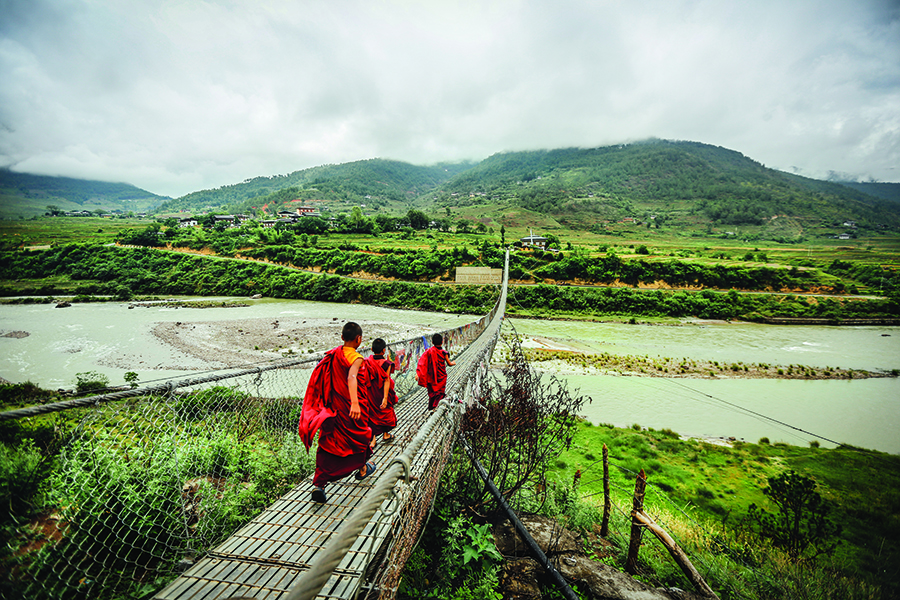Bhutan – known as ‘The Land of the Thunder Dragon’ is an incredible world of Himalayan mountains, magnificent fortresses, ancient monasteries and colourful Buddhist prayer flags. This secluded kingdom is relatively new to travel brochures, having only opened their doors to tourists in 1974, and has managed to maintain its strong heritage and culture.
There are some incredible cultural and festival-based options when putting together an itinerary in Bhutan, and these are both important components to experiencing this destination. But did you know you can also incorporate trekking into your itinerary?
We’ve asked the experts at Natural Focus all about trekking in Bhutan, for those wanting to include an active addition to their trip.
1. What time of the year is best to visit Bhutan, specifically if you’d like to incorporate trekking?
The best time to go is Spring (March to May), when Bhutan is in full bloom, or Autumn (September to November), when there is very little rain and the skies are clear, offering the best mountain viewing. For birdwatchers Winter (December to March) is the best time to view the famous Black-necked Cranes at their winter home in the Phobjikha Valley.
2. Are there multiple treks to choose from?
Yes there is a range of trekking from moderate to very challenging. Many travellers incorporate a few days of trekking into their sightseeing itinerary, like the 11 day Druk Path Trek which includes a 6 day trek, or the 11 day Bumthang Pilgrim Trek which includes a 3 day trek through the beautiful Bumthang Valley.

3. What fitness level is required for trekking in Bhutan?
This depends on the trek you are undertaking. In general you will need to be physically fit and used to long walks. The most challenging treks require a very high degree of fitness. Most shorter, moderate level trekking itineraries are designed to travel at a gentle pace. Altitude sickness can be a concern over 3,000m so it is important to acclimatise before your trek and ascend slowly.
4. How many days should travellers allow for the trekking part of their trip?
You can choose anything from 3 days to a week or longer. Or simply include one day or half day walks into your itinerary.
5. What sort of landscapes/scenery will trekkers see along the way?
Mountainous Bhutan is covered in ancient forests and alpine meadows. While trekking through the mountains, you may visit temples, chortens, dzongs and monasteries where few tourists have ever been. Trekking creates wonderful opportunities to visit remote villages and witness first hand the traditional culture and customs of the local people. Most treks go above 3,000m and on crystal-clear sunny days in spring and autumn, you are treated to dazzling views of the eastern Himalayas.

Image by David Kneale
6. What’s included on your trekking itineraries?
You will be accompanied by a local trekking guide, cook, camp hand and horsemen who look after the yaks and ponies that transport your luggage and camping gear. The crew take care of all the camp chores and will provide you with simple but wholesome food along the way. Most treks also include some nights in government approved hotels and guesthouses.
7. What is the altitude of the treks, for those concerned about altitude sickness?
Most of Bhutan is at quite a high altitude and altitude sickness can be a concern over 3,000m so it is important to acclimatise before your trek and ascend slowly. The Druk Path Trek goes up to 4200 metres (13,779 ft), whilst the moderate 3 day Bumthang trek stays under 3500 metres (11,400 ft). However the cultural tours are not a problem as most valleys are under 2,500 metres (8202 ft) and mountain passes just over 3000 (9842 ft).

8. Any other information you’d like to add about trekking in Bhutan?
All of our treks are completely tailor made. You can choose from a range of accommodation customised to suit your specific style and budget. Departure dates are of your own choosing although subject to the period of the trekking season. We help your consultant design your itinerary and trek to spend more time in the places you choose and with the activities you are most interested in.
If you’d like to know more about trekking in this fascinating part of the world, contact our team of experienced consultants today.






